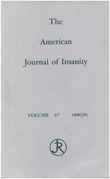Trauma-related symptoms in veterans of Operation Desert Storm: a 2-year follow-up
Abstract
OBJECTIVE: This study was a 2-year follow-up in an ongoing prospective examination of development of trauma-related symptoms over time in a community group of veterans of Operation Desert Storm. METHOD: Sixty- two National Guard reservists, from one medical and one military police unit, completed the Mississippi Scale for Combat-Related Posttraumatic Stress Disorder and a DSM-III-R-based posttraumatic stress disorder (PTSD) symptom scale 1 month, 6 months, and 2 years after returning from the Middle East. Differences in symptom severity over time were analyzed by using repeated measure analyses of variance. RESULTS: Scores on the Mississippi scale, but not the DSM-III-R PTSD scale, increased significantly over time. Symptoms of hyperarousal were more severe at all time points than were symptoms of reexperiencing or avoidance. Level of combat exposure, as reflected by the Desert Storm trauma questionnaire, was significantly associated with the score on the Mississippi scale at 2 years but not at 1 month or 6 months. All subjects who met the Mississippi scale's diagnostic criteria for PTSD at 1 or 6 months still met the criteria at 2 years. CONCLUSIONS: Although symptoms were relatively mild, there was an overall increase in PTSD symptoms over 2 years. The statistical relationship between level of combat exposure and PTSD symptoms at 2 years, and not before, suggests that it may take time for the consequences of traumatic exposure to become apparent. Moreover, degree of exposure may be important in predicting the eventual development of symptoms. Continued follow-up will address the evolution of PTSD symptoms in Gulf War veterans.
Access content
To read the fulltext, please use one of the options below to sign in or purchase access.- Personal login
- Institutional Login
- Sign in via OpenAthens
- Register for access
-
Please login/register if you wish to pair your device and check access availability.
Not a subscriber?
PsychiatryOnline subscription options offer access to the DSM-5 library, books, journals, CME, and patient resources. This all-in-one virtual library provides psychiatrists and mental health professionals with key resources for diagnosis, treatment, research, and professional development.
Need more help? PsychiatryOnline Customer Service may be reached by emailing [email protected] or by calling 800-368-5777 (in the U.S.) or 703-907-7322 (outside the U.S.).



